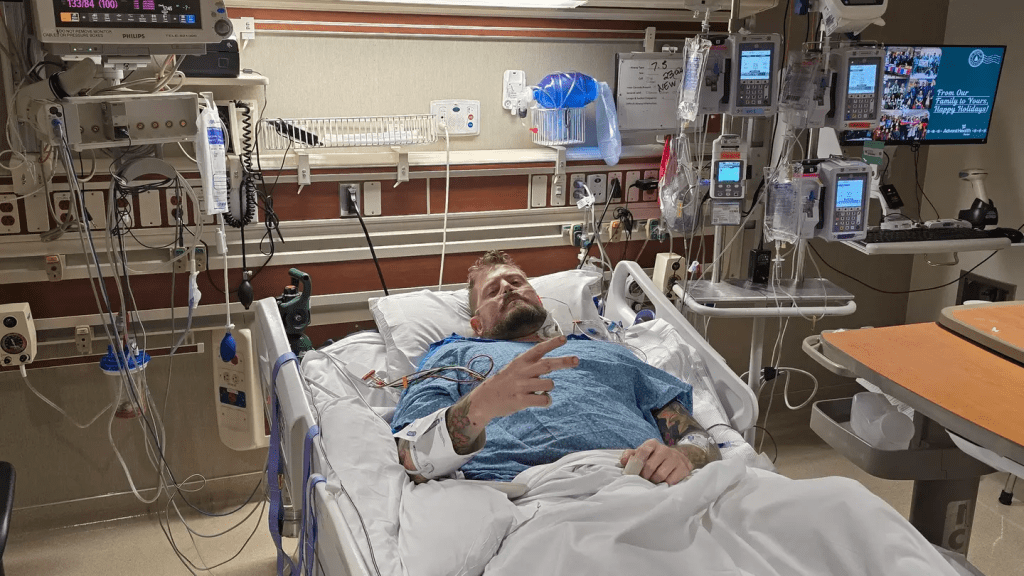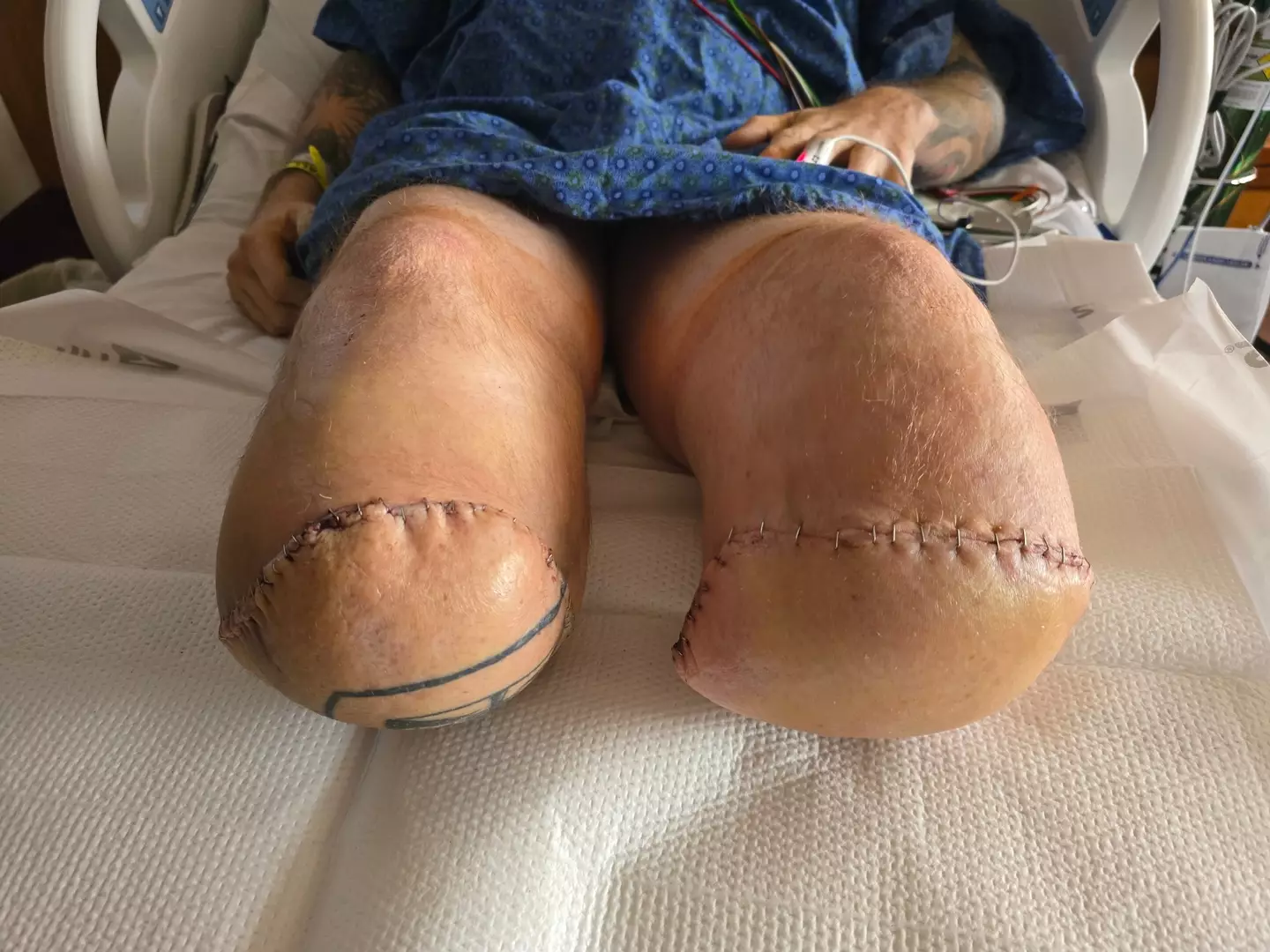Life can change in an instant, and for Max Armstrong, a simple cooking mishap led to a medical nightmare he never could have imagined. What began as a minor burn on his thumb quickly spiraled into a fight for survival, resulting in the amputation of both his legs.
This unbelievable story serves as a stark reminder of the hidden dangers of infections, the unpredictability of sepsis, and how even the smallest wounds should never be taken lightly.
A Simple Camping Trip Gone Terribly Wrong

Max Armstrong, a 40-year-old outdoor enthusiast, had always embraced adventure. In December, he set out for a week-long camping trip with friends in Kiowa, Colorado, looking forward to the peace of the wilderness.
One evening, while cooking pasta over an open fire, he accidentally grabbed a hot skillet the wrong way, burning his thumb. It was a quick, sharp pain—something he had experienced many times before while spending time outdoors.
“I could feel it burning as I moved it to the table, but I didn’t want to drop it,” he recalled. Thinking it was nothing serious, he cleaned the wound, wrapped it in a bandage, and went on with his trip.
The First Signs of Trouble
A few days later, Armstrong noticed that one of his legs had begun to swell. At first, he dismissed it, assuming he had twisted his ankle while navigating the rugged terrain.
“It wasn’t anything that seemed too serious at the time,” he said. “I figured it would go away on its own.”
But it didn’t. As the days passed, the swelling worsened, and his toenails began turning purple. Concerned but still unaware of the true danger he was in, Armstrong decided to cut the trip short and head home.
A Rapidly Escalating Medical Emergency
On December 7, Armstrong’s friend urged him to go to the hospital. With his condition worsening, he finally agreed and went to AdventHealth Parker.
By the time he arrived, the burn on his thumb had turned black and appeared to be deteriorating. As he sat in the hospital, discussing his symptoms with doctors, he suddenly started losing consciousness. His eyes rolled back, and his speech became incoherent.
That was the moment doctors realized something was terribly wrong.
The Shocking Diagnosis: Sepsis from Strep A
Medical tests revealed that Armstrong had been infected with a dangerous strain of Group A Streptococcus (Strep A). The bacteria had entered his bloodstream through the burn on his thumb, triggering sepsis, a life-threatening condition where the body’s response to infection causes organ failure and tissue damage.
His condition was so severe that doctors rushed to transfer him to AdventHealth Porter, a hospital better equipped to handle critical cases. There, he was placed in an induced coma for six days.
A Fight for Survival

While Armstrong lay in a coma, doctors worked tirelessly to keep him alive. His body was battling an extreme infection, and his loved ones were given devastating news—there was a very real chance he wouldn’t survive.
Miraculously, on December 13, Armstrong regained consciousness. His family and medical team were overjoyed, but the celebration was short-lived.
When Armstrong looked down at his legs, he was horrified to see that both were completely black. The sepsis had spread so aggressively that it had destroyed the tissue in his lower limbs, leaving doctors with no choice but to amputate.
The Heartbreaking Decision: Losing Both Legs
On December 23, Armstrong underwent a three-hour surgery to remove both of his legs in a desperate bid to save his life.
“When I woke up, I thought my legs were still there,” he recalled. “Then I reached down and realized they weren’t. That’s when the reality hit me.”
A nurse confirmed the tragic news, but she quickly reminded him that his family was waiting for him. It was this moment—knowing his loved ones were still by his side—that helped anchor him in his darkest hour.
The Road to Recovery
Armstrong spent another month in the hospital before being transferred to Sky Ridge Sports Medicine and Rehabilitation Clinic in Colorado, where he spent 16 more days adjusting to his new reality.
Now reliant on a wheelchair for mobility, he has shifted his focus to rebuilding his strength, particularly in his triceps and shoulders, which he calls his “lifeline” for independence.
How a Simple Burn Turned Into a Life-Threatening Condition

Armstrong’s case is a stark reminder of how seemingly minor injuries can lead to life-threatening complications. Sepsis, often called the “silent killer,” can escalate rapidly if left untreated.
Here’s how the infection took over his body:
- Initial Burn Injury – The small wound on his thumb provided an entry point for bacteria.
- Strep A Infection – The bacteria infiltrated his bloodstream and began attacking his body.
- Sepsis Sets In – His immune system, in overdrive, caused widespread inflammation, leading to organ and tissue damage.
- Tissue Necrosis (Death) – His legs, unable to fight off the infection, turned black and became unsalvageable.
The Importance of Early Treatment
Had Armstrong sought medical attention sooner, his outcome might have been different. Early symptoms of sepsis include:
- Unexplained swelling or discoloration
- Fever, chills, or extreme weakness
- Rapid breathing or heart rate
- Confusion or difficulty speaking
- Severe pain or discomfort
Seeking urgent medical care at the first sign of a serious infection can mean the difference between life and death.
Moving Forward with Strength and Determination

Despite the immense challenges ahead, Armstrong refuses to let his situation define him. He is determined to regain as much independence as possible and has set his sights on mastering life in a wheelchair.
“It was a hunting trip with friends that turned into a bit of a nightmare,” he admitted. “But I’m still here, and I have people who love and support me. That’s what matters.”
Final Thoughts: A Cautionary Tale About Sepsis
Max Armstrong’s story is both heartbreaking and eye-opening. What seemed like a harmless burn turned into a devastating medical emergency, proving how unpredictable and dangerous infections can be.
His journey serves as a crucial lesson: Never underestimate the risks of even the smallest injuries. If something doesn’t seem right, seek medical help immediately.
Life can change in an instant—but with awareness, vigilance, and timely medical intervention, tragedies like this can be prevented.


